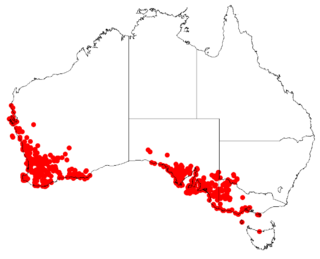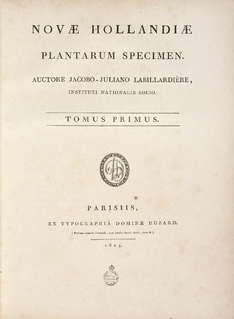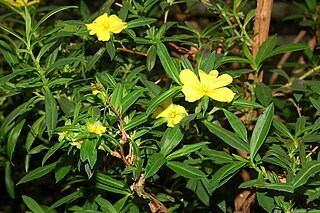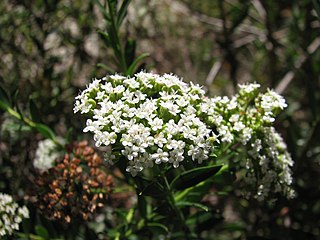
Podolepis is a genus of the pussy's-toes tribe within the daisy family. It is endemic to Australia and can be found in every state.

Blandfordia punicea, commonly known as Tasmanian Christmas bell, is a species of flowering plant that is endemic to western Tasmania. It is a tufted perennial herb with linear leaves and drooping red, bell-shaped flowers that are yellow on the inside.

Comesperma is a genus of shrubs, herbs and lianas in the family Polygalaceae. The genus is endemic to Australia. It was defined by the French botanist Jacques Labillardière in his 1806 work Novae Hollandiae Plantarum Specimen. The genus name is derived from the Ancient Greek words come ("hair") and sperma ("seed"), and relates to the seeds bearing tufts of hair. The genus is distributed over southern Australia, particularly in the southwest of Western Australia, where 19 species are found. 24 species have been described.

Melaleuca cuticularis, commonly known as the saltwater paperbark is a tree in the myrtle family, Myrtaceae and is native to the south-west of Western Australia. There is also a disjunct population on Kangaroo Island in South Australia. It is distinguished from other melaleucas by its unusual fruits and very white, papery bark.
Gahnia trifida, the coastal saw-sedge, is a tussock-forming perennial in the family Cyperaceae, endemic to southern Australia.

Brachyscome ciliaris, commonly known as variable daisy, is a small bushy perennial herb with a prominent flower, which occurs throughout most of temperate Australia

Podotheca angustifolia, commonly known as Sticky Longheads, is a species of herb native to Australia.

Novae Hollandiae Plantarum Specimen is a two-volume work describing the flora of Australia. Facsimiles of the originals can be found in the online Biodiversity Heritage Library (Vol.1) and Vol 2).

Muehlenbeckia adpressa, commonly known as climbing lignum, is a prostrate or climbing plant, native to Australia. It has thin red-brown stems up to 1 metre in length. The leaves are 1.5–6 centimetres (0.59–2.36 in) long and 1.5–3.5 centimetres (0.59–1.38 in) wide. It occurs in coastal areas of Western Australia, South Australia, Tasmania, Victoria and New South Wales.

Olearia ramulosa, the twiggy daisy-bush, is a species of flowering plant in the family Asteraceae. It occurs in New South Wales, Victoria, South Australia and Tasmania.

Siloxerus is a genus of Australian plants in the pussy's-toes tribe within the daisy family.

Calothamnus sanguineus, commonly known as silky-leaved blood flower, is a plant in the myrtle family, Myrtaceae and is endemic to the south-west of Western Australia. The Noongar peoples know the plant as Boolgalla. It is an erect to spreading shrub with short, cylindrical leaves and red or white flowers with an unusual arrangement of stamens, often flowering in autumn, winter or spring. It was the first of its genus to be formally described.

Comesperma volubile, commonly known as love creeper, is a slender climber in the family Polygalaceae. It grows to between 1 and 2 metres high. The leaves are 10 to 50 mm long and 1 to 5 mm wide. Blue or pale purple flowers are produced in sprays from July to December in the species' native range. It occurs in heathland and forest in the states of Western Australia, South Australia, Tasmania, Victoria, New South Wales and Queensland in Australia.

Hibbertia cuneiformis, commonly known as cut-leaf hibbertia, is a shrub species that is endemic to the south-west of Western Australia. It grows to between 1 and 2 metres tall and has yellow flowers which appear from January to March and June to November in the species' native range.

Stackhousia monogyna, commonly known as creamy stackhousia or creamy candles, is a perennial herb species in the family Celastraceae. It is native to Australia. Plants grow to 70 cm (28 in) high and produce a terminal spike of white, cream or yellow flowers between August and January in the species' native range.

Platysace lanceolata, commonly known as shrubby platysace, is a shrub species that is native to south-eastern Australia. It grows to 1.5 metres high and has leaves that are 10 to 50 mm long and 4 to 5 mm wide. Plants produce umbels of small white 5-petalled flowers between December and February in the species native range.

Anthocercis littorea, also known as yellow tailflower, is a species of shrub in the family Solanaceae. It's native to Western Australia where it grows on coastal limestone and dunes as well as sandplains. It usually grows to between 0.6 and 3 metres in height and produces yellow flowers throughout the year in its native range.

Phyllanthus calycinus, known as false boronia and snowdrop spurge, is a small shrub in the family Phyllanthaceae, which grows to heights from 20 cm to 1.2 m, often on sandy soils. It is found in both Western Australia and South Australia. In Western Australia its white-cream to pink flowers may be seen from June to January, and in South Australia, from May to October.

Comesperma calymega, commonly known as blue-spike milkwort, is a slender herb in the family Polygalaceae. It is a perennial herb growing to between 10 cm and 50 cm high, from a short woody rhizome.

Comesperma integerrimum is a twining shrub or climber in the family Polygalaceae.




















